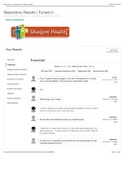Study guide
IB Business Management Topic 2 - Study Guide/Revision Notes for HUMAN RESOURCE MANAGEMENT
- Vak
- Instelling
- Boek
A complete study guide and revision notes for the IB Diploma Business Management program. I achieved a 43 predicted in the IB program and scored a 7 overall for my HL final business management grade by using these notes to study. These notes include all aspects listed in the IB syllabus as well...
[Meer zien]















